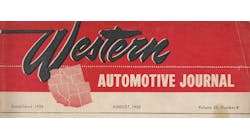No matter how long someone has been in the collision repair industry, everyone has to start somewhere. From the seasoned professional to the new recruit, carving a career path in this industry takes perseverance, dedication, motivation and passion.
Currently, the automotive aftermarket is faced with a labor shortage. According to the 2022 FenderBender Industry Survey Report, 22 percent of respondents think that low labor rates are the biggest challenge facing shop operators today. 34 percent of respondents cite a shortage of qualified technicians as the most challenging aspect.
Both responses prove that the industry needs to focus on new ways of recruitment in order to fill the need. One way of doing this is by looking outside of the industry for qualified individuals whose work skills can translate into collision repair. This is how some lasting careers can be developed.
Susan Bock, Senior Associate, Industry Technical Relations at I-CAR, is a perfect example of this. After a career outside of the collision repair industry, she took a chance. She discovered some wonderful opportunities, and is now even able to give back to the industry she has come to love.
Find A Starting Place
It all started with insurance. Bock spent almost sixteen and a half years as a licensed property and casualty insurance agent. She was laid off in 2009 when the market crashed, but because her employer had laid off 50 percent of the workforce she was able to go to workforce development and get benefits towards education.
This is what led her to the course catalog of Fox Valley Technical College of Appleton, Wisconsin. At the very back, she found the Vehicle Refinishing and Repair Technology associate degree program.
“I started thinking, if I didn’t have to do insurance, here’s my opportunity to get a degree and to do something different.” Bock says.
At 39 years old with no prior industry experience, Bock jumped headfirst into the program. She describes the experience as eye-opening.
“I had a complete misconception of how much knowledge you need to have to actually know how to do the repairs; to understand what you’re repairing, and how to repair it.” Bock says.
Although it wasn’t an easy transition, Bock looks back on the experience fondly, growing pains and all. By applying herself to the work, doors eventually opened to apply herself even further.
Soon enough, she was made aware of the 2009 AkzoNobel Most Influential Women of the Year in Collision Repair Industry Scholarship opportunity through the Collision Repair Education Foundation.
She credits Joe Kircher and Jerry Goodson, two of her instructors at the time, with encouraging her to sit down, write the essay for the application, and just see what could happen.
“I remember where I was when Joe came up to me in class on a Friday morning,” Bock says. “We were getting ready to cut sheet metal and he goes; ‘Jerry just let me know you won a $5,000 scholarship.’ I was kind of shell shocked and he says; ‘I’ve lost you for the morning, haven’t I?’ and I said; ‘Kinda!’”
Bock was able to put the money she received from winning the scholarship towards reimbursement for repair tools. Bock says that because of this, she was able to have confidence regarding proper preparedness for her career.
Discover Opportunity
Being awarded the scholarship helped set Bock up for long term success, especially as someone who was new to the industry.
“[The scholarship] not only made me aware of CREF, but it also made me aware of I-CAR.” Bock says. “I didn’t realize there were all these other aspects to collision repair other than writing estimates, doing damage appraising, or working on the vehicle. I had no concept that there was this whole other avenue of employment opportunity.”
It’s this kind of thinking that helped get Bock from starting at I-CAR as an Instructional Designer to where she is today as an Senior Associate, Industry Technical Relations.
“I realized I could use my education to learn about writing curriculum and helping out the industry from a whole other angle,” Bock says.
In her current role, she fields incoming phone calls and emails for “Ask I-CAR” from technicians and insurance professionals inquiring about what can and can’t be done in regards to effective collision repair.
When Bock initially started with I-CAR, she was immediately intent on giving back to CREF, the program that had helped her so much.
“As soon as I found out you could do an automatic check withdrawal for donation each pay period, I said sign me up. I wanted to be able to keep paying it forward.” Bock says. “For the first time in my life I had gotten a college education that moved me forward confidence-wise and it put me on a new career path. I just want to make sure there are still funds going to CREF to help other students that want to go into collision repair, but they’re lacking the funds or they need the help.”
Paying it forward is something that Bock is proud to do, especially considering the current labor climate. She wants others to feel inspired to pursue collision repair, even as changes in vehicle technology and repair procedures pose new challenges and new ways of thinking.
“It's going to be challenging. But, it's going to be a really worthwhile profession to get into.” Bock says. “It’s never the same, which is fantastic, as you will never end up bored.”
Pave the Path Ahead
Given the right amount of support, enthusiasm and encouragement, Bock believes in a bright future for recruiting collision repair professionals.
Her perspective has allowed her to see all of the strengths that an individual can bring into the field, even if they don’t have any prior experience. Through her education, her scholarship opportunity and most importantly her determination, she has established a successful career.
Bock is a shining example of the talent to be found outside of the industry bubble, and as we face a future that is more technology-oriented, looking from the outside in may be the best route.
“It sounds so cliche but just because that’s how it’s always been done, that doesn’t mean that’s how you [have to] do it now.” Bock says.
Bock knows a thing or two about breaking with tradition as well. She is a woman in a mostly male dominated field making a mark that lasts while inspiring and impacting those who will come after her.
“No matter what you’re doing in life, you’ve got to prove that you know what you’re doing.” Bock says. “One of my favorite phone calls I got was from a gentleman who said; ‘They let ladies do this?’ and I laughed and said; ‘Yes, yes they do.’”




